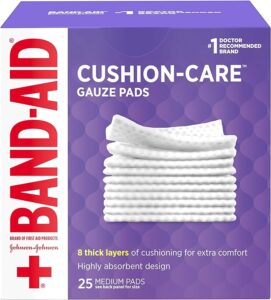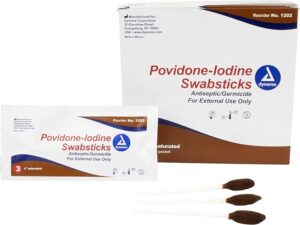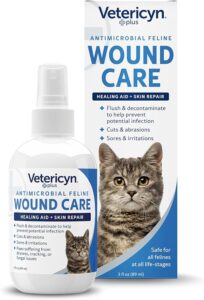Introduction
As a cat owner you know that your feline friend can sometimes come home with a few battle scars. This mostly happens because of their outdoor adventures. One common injury is a cat’s ear wound. Whether from a fight with another animal or a misadventure while exploring the outdoors, ear wounds can be painful for your cat and require proper treatment. In this article, we’ll cover everything you need to know about cat ear wounds. Including their causes, symptoms, and how to treat them.
Common Causes of Cat's Ear Wound
Cat fights
Cats are territorial animals, and fights with other cats are a common cause of ear wounds. During a fight, cats can scratch or bite each other, causing injuries to the ear and other body parts.
Scratches from sharp objects
Cats are curious creatures and love to explore their environment. Sometimes, they may get into situations where they scratch themselves on sharp objects, such as bushes, fences, or wires.
Insect bites
Insects, such as fleas or ticks, can also cause ear wounds in cats. These bites can be itchy and irritating, causing your cat to scratch their ears excessively and potentially leading to a wound. In that case they created the wound themselves.
Allergic reactions
Some cats may have allergic reactions to certain materials, such as certain fabrics, pollen, cleaning products, or even their food. These reactions can cause skin irritation and itching, which may lead to a cat ear wound if the cat scratches excessively.
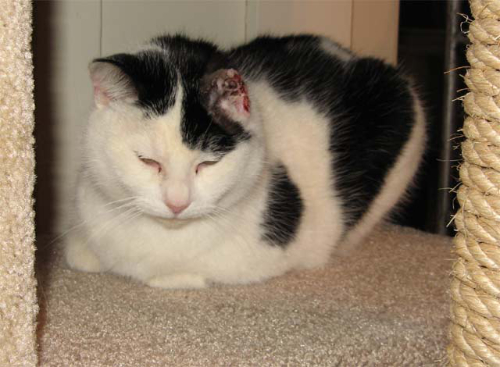
Symptoms of a Cat's Ear Wound
If your cat has an ear wound, they may exhibit one or more of the following symptoms:
Visible wounds on the ear
The most obvious symptom of a cat ear wound is a visible injury on the ear. This can include cuts, lacerations, puncture wounds, or other types of damage to the skin.
Excessive scratching or shaking of the head
Cats with ear wounds may scratch or shake their heads more than usual. This is because the wound may be itchy or painful, and the cat may be trying to alleviate their discomfort. If you don’t see any wounds, check the ear canal. Your cat will probably have an ear infection.
Discharge or bleeding from the ear
If your cat has an ear wound, they may have discharge or bleeding from the affected ear. This can be a sign of infection or other complications and should best be addressed by a veterinarian.
Foul odor coming from the ear
Another symptom of a cat ear wound is a foul odor coming from the affected ear. This can be a sign of infection of your cat’s ear wound.
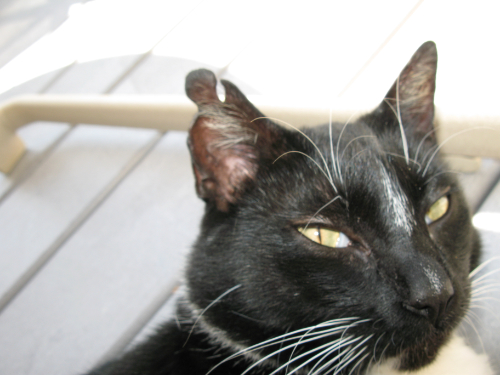
How to Treat a Cat's Ear Wound
If you notice that your cat has an ear wound, it’s important to take prompt action to address the injury. The treatment for a cat ear wound will depend on the severity of the injury.
Importance of seeking veterinary care for serious or deep wounds
If your cat’s ear wound is deep or severe, you should seek veterinary care immediately. Deep wounds can be dangerous, as they may be prone to infection. It also can cause other complications if left untreated. A veterinarian will be able to assess the extent of the injury and provide appropriate treatment. That can be an operation or just a course of antibiotics and painkillers.
At-home care for minor wounds, including cleaning with a pet-safe disinfectant and applying a pet-safe wound cream
If your cat has a minor ear wound, you may be able to treat it at home. Start by cleaning the affected area with water and a gauze pad.
After cleaning you should apply a pet-safe disinfectant. For cat’s betadine can be used as long as they don’t lick the wounds. They can get diarrhea if they ingest it. It is best to use swabsticks like below. It is easy to apply and you can not spill on your cat.
After desinfecting the wound, you can apply a pet-safe wound cream to the wound to promote healing and prevent infection.
It’s important to monitor your cat’s wound closely and seek veterinary care if you notice any signs of infection or if the wound does not appear to be healing. In some cases, your vet may recommend additional treatment or prescribe antibiotics to help your cat recover fully.
Does a Cat's Ear Wound Heal on it's Own?
Cat ear wounds can heal on their own, but the severity of the wound will affect the healing time. Minor wounds, such as small scratches or cuts, may heal within a week with proper at-home care. However, more severe wounds, such as deep puncture wounds or lacerations, may take several weeks to heal completely. They even may require veterinary intervention.
It’s important to monitor the wound closely and watch for signs of infection, such as discharge or foul odor. This can indicate that the wound is not healing properly. Lack of healing progress can also indicate that veterinary care is necessary to prevent complications.
In addition to providing appropriate care for your cat’s wound, it’s important to make sure that your cat is comfortable and has everything they need to heal properly. This includes providing a clean and quiet space for your cat to rest, as well as ensuring that they have access to fresh water and food without hurting them on the painful ear.
Remember that every cat and every wound is different, and the healing time and process may vary. If you have any concerns about your cat’s ear wound, it’s important to seek veterinary care promptly to ensure the best possible outcome.
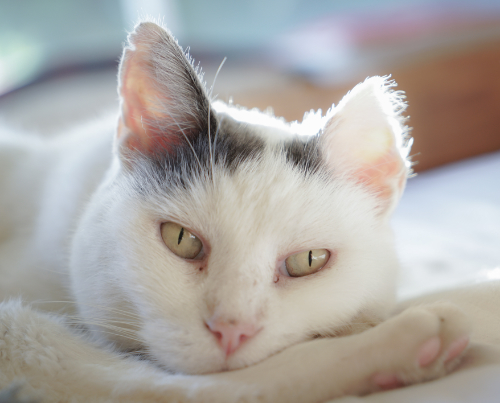
How Long Does it Take for a Cat's Ear to Heal?
The length of time it takes for a cat’s ear to heal will depend on a variety of factors, including the severity of the wound and the individual cat’s healing abilities. Minor wounds may heal within a week with proper care, while more severe wounds may take several weeks to fully heal.
In addition to the severity of the wound, there are other factors that can affect healing time. Age and overall health can play a role in how quickly a cat’s wound heals. Younger cats and those in good health may heal more quickly than older cats or those with underlying health conditions. If you want the skin to heal faster it is important to upgrade the skin resistance with salmon oil.
It’s important to note that every cat and every wound is unique, and healing time can vary. If you’re concerned about the healing progress of your cat’s ear wound, it’s important to consult with a veterinarian. They can assess the wound and provide recommendations for how to support your cat’s healing process.
What to Do if a Cat's Ear Wound Won't Heal
If your cat’s ear wound is not healing or if it’s showing signs of infection, it’s important to seek veterinary care promptly. A wound that is not healing can indicate an underlying issue or infection, which can lead to complications if left untreated.
Your veterinarian may recommend additional treatment options for non-healing wounds. Antibiotics may be necessary to treat underlying infections, while surgery may be necessary to remove damaged tissue and promote healing. Your veterinarian can assess the wound and provide recommendations for the most appropriate course of treatment for your cat.
It’s important to note that some wounds may take longer to heal than others, and the healing process can vary depending on the individual cat and the severity of the wound. However, if you’re concerned about your cat’s wound, don’t hesitate to seek veterinary care to ensure the best possible outcome for your furry friend.
In addition to seeking veterinary care, you can support your cat’s healing process by providing appropriate care at home, such as cleaning the wound with a pet-safe disinfectant like betadine twice a day and applying a pet-safe wound cream. Ensure that your cat has a comfortable and quiet space to rest and that they have access to fresh water and food.
What Clipped Ears on Cats Mean
If you’ve ever seen a feral cat with a clipped ear, you may have wondered what it means. Clipping a cat’s ear is a common practice used to identify feral cats that have been spayed or neutered. This practice, known as ear tipping, involves removing the tip of one ear while the cat is under anesthesia for the spay or neuter procedure.
Ear tipping helps identify cats that have already been spayed or neutered, so they don’t undergo unnecessary surgeries, and it also helps feral cat caretakers keep track of their colonies. Ear tipping is considered a humane and effective way to manage feral cat populations, as it allows for the identification and care of these animals while minimizing their impact on the environment.
It’s important to note that ear tipping is different from cutting a cat’s ear as a result of injury or medical procedure. While the clipped ear on a feral cat serves as a marker for identification, a cut ear on a domestic cat may indicate a medical issue that requires treatment. If you notice a cut or wound on your cat’s ear, it’s important to seek veterinary care to determine the cause and appropriate course of treatment.
Conclusion
In conclusion, cat ear wounds can be a common issue for feline owners. It’s important to monitor your cat’s ears for signs of injury and seek veterinary care for serious wounds or those that are not healing properly.
Minor wounds can often be treated at home with proper cleaning and wound care products. But it’s important to use pet-safe products and consult with a veterinarian if you have any concerns.
Remember, cat ear wounds can vary in severity and healing time, so it’s important to be patient and monitor the wound closely. If you notice any signs of infection or lack of healing progress, seek veterinary care immediately.

